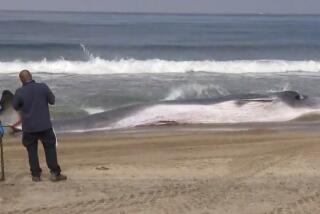Conservationist Doing Right by Threatened Whale
IMBITUBA, Brazil â His raft adrift in the languid, turquoise waters of the South Atlantic, Jose Truda Palazzo focuses his binoculars on a shadow in the depths to the east.
âThere!â he shouts. âThere! Sheâs coming up to jump! Quick, get that motor going!â
In seconds, the shadow grows long and dark. Then the surface of the ocean bulges and out bursts a rare sight--a southern right whale, the second most endangered whale species on the planet.
The whale rises immensely, water pouring from her sides. Her bulk is black and oily smooth and tapered like a submarine. And when she crashes back into the sea, the spray roars up in a curtain of crystalline drops.
She submerges in a slow slant, then rises again, the hump of her back awash as she breaks the surface to breathe. Up goes a spout, high, pluming like a geyser.
âFor the love of God,â gasps Palazzo, a conservationist who has studied right whales for 15 years. âSheâs got to be 40, no, 50 feet long.â
Suddenly, there is another boil in the water--a four-ton calf jumping. He leaps on his motherâs back and rolls about, butting his blunt head against her.
Palazzo smiles. âItâs really gratifying to see them here, in Imbituba,â he says, âsince this is where thousands of whales were butchered at the local whaling station.â
Three decades ago, these docile creatures appeared doomed to extinction. Whalers overhunted them. Trawlers frightened them away from their warm-water spawning grounds. Scientists cut them up for research.
By 1973, they had vanished from Brazilian waters. Fewer than 400 were known to survive on Earth.
Today the right whales are making a comeback off Brazilâs southern seaboard, thanks largely to Palazzoâs crusade to protect them and their underwater world.
With help from the International Wildlife Coalition, the Summerlee Foundation in Dallas and the British Whale and Dolphin Conservation Society, Palazzo manages a project that studies the whales and persuades fishermen to spare them.
Last year, he documented 48 right whales off Brazil. Worldwide, the population has recovered to about 4,000.
âTrudaâs work is crucial because Brazil is where right whales bear and nurture their calves,â says Dave Wiley, a senior scientist at the World Wildlife Coalition in Cape Cod, Mass. âItâs remarkable how Truda has produced such phenomenal results with so little money. Heâs basically running a one-man show down there.â
The Right Whale Project, begun in 1982, also provides scientists new insights into the habits and makeup of the creature Brazilians call baleia franca--Portuguese for âfree whale.â
âWhen we started, we knew almost nothing about them,â Palazzo says. âEven now, we still donât know basic things, like their complete migration routes or the dangers they face.â
But his research has peeled away some of the mysteries of this primitive creature, a mammal uniquely adapted to both the near-freezing waters of the Antarctic and the tepid seas of the South Atlantic.
Like its endangered northern cousin found off Cape Cod, Mass., the southern right whale has existed for about 60 million years.
Enormous--18 yards long, 11 feet wide and weighing 40 to 60 tons when full grown--the right whale has no natural enemies except man.
Scientists identify the right whale by its black body, two rectangular pectoral fins, V-tail and white, wartlike ripples along its blunt head that look as if someone had run a finger through warm wax.
âThose ridges are like fingerprints--no two whales have the same ridges,â Palazzo says. âThatâs how we tell them apart.â
During the Southern Hemisphere summer, from December to March, adults feed in the Antarctic. These toothless creatures consume five tons of tiny sea organisms a day by straining them through a baleen, an elastic whalebone that hangs in parallel, platelike fringes from the upper jaw.
The monstrous diet helps them pad a 16-inch layer of blubber that insulates them from the cold and satisfies them the eight months they spend away from the South Pole.
As winter approaches, the right whales migrate north, to warmer waters off South Africa, Australia, Argentina and Brazil. Last year, naturalists spotted them off New Zealand for the first time.
Moving no faster than 15 mph, the right whales migrate to Tierra del Fuego at the tip of South America and up to Argentinaâs Valdez Peninsula, before proceeding past Uruguay to Brazil.
After a 2,000-mile journey, they arrive in May off the Brazilian coastal states of Rio Grande do Sul and Santa Catarina and begin mating.
Whale sex isnât exactly lovey-dovey. Four to five males approach the female at once, groaning and bellowing, and she resists them by turning upside down and keeping her belly out of the water.
For hours the males try to flip her over. When she finally tires, her suitors fight to go first. âItâs total mayhem,â Palazzo says. âMy advice to whale watchers: Stay away while theyâre copulating.â
Chances are good the female will become pregnant: Each male penetrates her, injects his sperm in seconds and departs.
Females swim back to Antarctica to feed and return 12 months later to give birth. Right whales usually weigh four tons at birth but grow quickly, feeding on their motherâs fatty, highly nutritive milk.
When Portuguese colonizers arrived in 1500, tens of thousands of right whales thrived along the 2,200 miles of Brazilian coastline stretching from Rio Grande do Sul to Bahia state.
In the 17th and 18th centuries, Franciscan priests wrote in their diaries that they had trouble sleeping at night because of the moaning of whales in the bay of Salvador, the colonial capital of Brazil.
In 1632, the king of Portugal issued the first whaling concession in Salvador, initiating three and a half centuries of uncontrolled whaling.
Slow and easy to track by their spouts, the eubalaena australis received the name right whales because fishermen considered them the âright,â or easiest, whales to kill.
Ropes fastened easily to the right whalesâ outer layer of blubber, and, unlike other whales that sank quickly after death, the right whale floated--buoyed by its fat--making it easy to tow to port.
But what really made the right whale an easy target was its friendly nature. With no fear of man, the whales innocently swam within 30 yards of shore.
Females with young were especially vulnerable. A common tactic was for whalers to trap infants in nets to attract the mother, then slaughter them both.
Prized for its blubber, meat, oil and whalebone, the right whale provided the economic backbone for colonial Brazil.
Its oil was used for cooking, street lamps and, before cement was invented, to bond and waterproof mud used to build homes. Whale hides were salted and made into gaskets, belts and hoses.
Whalebone was fashioned into corsets and whips. And the whaleâs tart meat, fried and stored in its own fat, commanded a top price at outdoor markets.
At the whaling industryâs peak in the mid-18th century, whaling stations known as armacaoes--traps--appeared every 125 miles along Brazilâs seaboard.
In those days, when 400 to 600 whales were killed each year off the coast of Santa Catarina alone, overhunting was already evident.
Right whales gradually vanished off Bahia, Espirito Santo, Rio de Janeiro, Sao Paulo and Parana states. By the 1890s, fisherman reported just six kills a year off Santa Catarina.
That number dwindled to three by 1950. A decade later, only one whaling station remained in operation--the armacao at Imbituba, 60 miles south of the state capital of Florianopolis.
In 1973, marine biologists pronounced the right whales extinct in Brazil and the Imbituba station, where 350 whales were slaughtered a year at the turn of the century, finally closed its kilns.
Eight years passed, and scientists wrote off any possibility the creatures might return.
But navy Adm. Ibsen Camara, the vice commander of Brazilâs armed forces and the only outspoken critic of whaling during the 1964-1985 military regime, thought otherwise.
With a $1,000 grant from the University of Miami, he called Palazzo, then a first-year biology major at college, and asked him to look for the whales off the shores of Santa Catarina.
For more than a year, the portly, spectacled 18-year-old cut classes and exams and spent weekends camping on beaches up and down the state searching for the whales, to no avail.
With his grant money running out, Palazzo tried the island of Sao Francisco do Sul in September 1982. Fishermen had told of seeing a great black fish swimming close to shore.
It was 8 a.m. and he was walking along the beach when a spout offshore caught his eye.
âThis big, black thing was rising and falling in the water,â recalls Palazzo. âIt was a whale, and she had a nylon gill net caught in her fin. I fell down on my knees and started to cry.â
In 1986, Palazzo received an $8,000 grant from the World Wildlife Fund to study the whales and to teach conservation to fishermen, using books and slide shows.
âThere was a radical change in the fishermenâs behavior,â he says. âThey understood how important it was to save the whales, and they began to volunteer to protect them.â
A year later, the government imposed a whaling ban. Offenders were punished with five-year prison terms and the seizure of their boats and equipment.
Last year, Santa Catarina Gov. Paulo Afonso declared state waters a whale refuge and ordered state police to patrol for clandestine whalers.
Today, scientists say the right whale population is growing by 8% a year.
But its future is hardly guaranteed.
Environmental groups facing shrinking donations are cutting outlays. In May, the International Wildlife Coalition--Palazzoâs main sponsor--halved its $30,000-a-year funding.
Meanwhile, the equipment needed to monitor the whales grows costlier and results, not surprisingly, are slow.
To track the whales, Palazzo wants to tag them with high frequency transmitters that can be monitored by satellite. But each tag costs $3,000, and the satellite hookup $1,000.
âItâs futile to protect them here and leave them exposed in other areas,â he says. âWe need to discover their migration paths to keep whalers away from them on the high seas.â
One big enemy is the Japanese whaler.
Every year, Japanese ships go to Antarctica and hunt countless endangered species. Meanwhile, lobbyists from Tokyo exert pressure on the International Whaling Commission to end the 1986 worldwide ban.
A more subtle threat to the whales is the contamination of their marine environment with organochlorine compounds, such as DDTs and PCBs.
Studies show that arctic waters act as a sink for organochlorines. The contaminants tend to accumulate in the whaleâs blubber, and mothers pass their toxic load on to their babies through their milk.
Each generation of whales starts out with more toxins than the previous one, a process known as bio-magnification, says Allison Smith of the British Whale and Dolphin Conservation Society in Bath, England.
âWhat will ultimately decide the fate of the whales will be what the average person throws away in his kitchen sink or trash can,â she says.
But Palazzo remains enthusiastic.
Recently, he has been working to start a tourism agency that he hopes will attract whale watchers from around the world. The revenue, he says, will be put back into the project.
He works around the clock, spends weekends away from his wife and two children and has spent all of his inheritance to keep the whale project going. Will he ever give up?
âNo way,â Palazzo says. âTo meet a right whale is to face 60 million years of evolution. Theyâve managed to survive all this time. We canât just let them die off now.â
More to Read
Sign up for Essential California
The most important California stories and recommendations in your inbox every morning.
You may occasionally receive promotional content from the Los Angeles Times.










